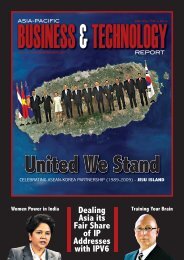GreeN Growth - Asia-Pacific Business and Technology Report
GreeN Growth - Asia-Pacific Business and Technology Report
GreeN Growth - Asia-Pacific Business and Technology Report
- No tags were found...
Create successful ePaper yourself
Turn your PDF publications into a flip-book with our unique Google optimized e-Paper software.
diplomacyChina Fights for the Richesof the South China SeaBy Donald KirkThe sparks are flying inwhat has been a diplomatic<strong>and</strong> propag<strong>and</strong>awar for a little-known isl<strong>and</strong>chain claimed in whole orin part by half a dozen powers,notably China but alsoTaiwan, Vietnam, the Philippines,Malaysia, <strong>and</strong> Brunei.Stunnedmullett | Dreamstime.comMysterious sightings of Chinese warplanesover distant islets, atolls, <strong>and</strong> reefs inthe South China Sea have fueled reports ofChina’s expansionist aims in these troubledwaters. They have assumed importance withthe realization that a fortune in oil <strong>and</strong> gaslingers beneath the shallow sea. The contestmost recently has involved a strange realignmentof interests in which big brotherChina, Hanoi’s main ally in the war that culminatedin the victory of North Vietnam’sforces in 1975, is now Vietnam’s foe.Hostilities so far have consisted of sporadic“incidents.” Vietnam accused a Chinese fishingboat of deliberately getting entangled inthe cables of a Vietnamese vessel lookingfor oil <strong>and</strong> gas on behalf of Petro Vietnam,Vietnam’s state energy company. The Chineseaccused the Vietnamese of draggingthe Chinese vessel for 30 minutes beforetwo more Chinese boats came to the rescue.Earlier, the cables of another such Vietnamesevessel were slashed. Finally, China senta 3,000-ton maritime patrol boat, the Haixun31, complete with helipad, to reinforce“rights <strong>and</strong> sovereignty” over 1.7-millionsquare miles of the South China Sea, includingthe Spratlys <strong>and</strong> the Paracels, anotherisl<strong>and</strong> grouping to the north. The Haixun 31would “carry out patrolling of the marineareas being developed in the South ChinaSea,” said Takung Pao, a newspaper in HongKong that has long been a mouthpiece forBeijing. Vietnam responded with live-fireexercises off its coast, <strong>and</strong> demonstratorsprotested outside the Chinese embassy inHanoi <strong>and</strong> the Chinese consulate-general inHo Chi Minh City. “Stop the invasion,” saidone of the signs in Vietnamese.The government-sanctioned outpouringof widespread Vietnamese sentiment wasbackground music to formal statements<strong>and</strong> protests. Prime Minister Nguyen TanDung led the chorus, declaring the country’ssovereignty was “incontestable” <strong>and</strong>proclaimed his determination to defend it.At the heart of the Vietnamese st<strong>and</strong> wasa geographical fact that the Chinese preferto ignore. The Vietnamese were looking foroil <strong>and</strong> gas inside their 200-mile, 370-kilometer“exclusion zone,” within which theyclaimed the right to do as they pleased inaccordance with the 1982 United NationsConvention on the Law of the Sea.Actually, relations between China <strong>and</strong>Vietnam began deteriorating even beforethe momentous victory of communist forcesfrom North Vietnam in their war againstthe American-backed South Vietnameseregime in 1975. China seized the Paracelsfrom South Vietnam in 1974 but refusedto turn them over to its former Vietnameseally. Then, China backed the KhmerRouge through nearly four years of bloodyrule over Cambodia before the Vietnamesedrove out the Khmer Rouge regime in 1978.Next, China attacked Vietnam’s northernfrontier at the end of 1978. The Vietnamesefended off that invasion with the same ferocitywith which they have battled the Chineseperiodically over the centuries. Morequietly, they occupied half a dozen atolls inthe Spratlys, sending in tanks as artillerypieces while dispatching marines <strong>and</strong> patrolboats.Over the years, China has seized atollsin the Spratlys <strong>and</strong> built facilities servicedby Chinese navy vessels, thinly disguised astrawlers. The Chinese, who first occupiednine of the isl<strong>and</strong>s in the 1950s, control ananchorage known as Mischief Reef, whosesubsurface atolls shelter a horseshoe-shapedlagoon that forms an anchorage four kilometerslong <strong>and</strong> two kilometers wide. Nowit is feared the Chinese want to form a smallairstrip on the reef, several feet above waterat low tide but only inches above the wavesat high tide. Yes, it would be an engineering“miracle,” but it could happen. Complicatingmatters still further, the anti-communist“nationalist” Republic of China onTaiwan has held the biggest of the Spratlyssince the surrender of the Japanese at theend of World War II. “Nationalist” Chinesetroops have never relinquished the isl<strong>and</strong>despite their defeat on the Chinese mainl<strong>and</strong>in 1949.The Philippines controls the second biggestisl<strong>and</strong> in the Spratlys, 200 miles west ofthe long Philippine isl<strong>and</strong> province of Palawanoff the west coast of Mindanao. Theisl<strong>and</strong>, named Pagasa, has no permanentresidents but boasts a lighthouse, municipalhall <strong>and</strong> multi-purpose building, a post office<strong>and</strong> clinic, all for 75 to 100 constructionworkers who get there by planes that l<strong>and</strong>on a 2,000-foot airstrip. There are no realpermanent residents, but life is not totallyaustere. There’s fishing <strong>and</strong> swimming, <strong>and</strong>the recreation hall features karaoke <strong>and</strong> billiards.There’s also an elected “mayor” whoclaims Pagasa as home though he lives mostof the time in Puerto Princesa, Palawan’scapital.China initially denied a report that twoof its MiG fighters buzzed the area, butthere was no question something was goingon after Chinese patrol boats were seen onChina’s national television network blastingaway at one of the atolls while a pair of MiGfighters zoomed above. It was all a militaryexercise, according to the official report,featuring fourteen boats “defending atolls<strong>and</strong> protecting sea lanes” as they pretendedto be attacking submarines while leapinginto the surf <strong>and</strong> running onto beaches.The confrontation over the isl<strong>and</strong> groupingof strategic <strong>and</strong> economic significancegoes back decades. Named for the 19th-centuryEnglish sea captain who sighted them,the Spratly Isl<strong>and</strong>s persist as an issue whileChina increases its strength in the face ofprotests from the Philippines <strong>and</strong> Vietnam.The problem for the Philippines is thattheir forces have their h<strong>and</strong>s full combatingsimmering revolts by communist <strong>and</strong>Muslim grouping elsewhere, <strong>and</strong> do nothave a clear sense of what’s happening onthe Spratlys. Thus it was that the Philippinespresident, Benigno “Nonoy” Aquino,spoke in the vaguest of terms when askedwhat he believed the Chinese were doing.Regarding the MiG sightings, he did notthink it was “established conclusively thatthey were from China” <strong>and</strong> “it’s difficult toaccuse them when it’s not very clear whosethey are.”The dispute over the isl<strong>and</strong>s confrontsWashington with a delicate diplomatic <strong>and</strong>military puzzle. The US <strong>and</strong> the Philippinesare locked in a mutual defense treaty thathas survived for 60 years despite the Philippines’refusal to extend the agreementfor enormous US air <strong>and</strong> naval bases in the1990s. Several hundred US military advisersare now “embedded,” as a US official put it,advising ill-equipped troops on combatingrevolt in Muslim-dominated southern Mindanao<strong>and</strong> the Sulu archipelago. US militaryreservists regularly come here for joint exerciseswith Philippine forces. Washingtonshies away, however, from any plan forworking with the Philippines on the defenseof Philippine claims in the Spratlysother than to reaffirm the US commitmentto the mutual defense treaty.Indicative of US reluctance to get involved,the American ambassador to thePhilippines, Harry K. Thomas Jr., hostingPresident Aquino at a reception aboard theUS aircraft carrier Carl Vinson, said, “Weare dedicated to being your partner wheneveryou are in harm’s way” – all part of “acommitment born of our shared histories<strong>and</strong> close ties.” Beyond such generalities, USofficials won’t get into specifics or detailsabout a commitment to the Philippines inthe Spratlys.Washington, in fact, would like to remainabove the fray, calling for a multilateral underst<strong>and</strong>ing.That’s anathema to Beijing,which insists on bilateral talks with each ofthe claimants – a ruse to keep them fromforming a de facto alliance against Chineseambitions. The US, however, is not backingoff entirely. US navy ships occasionally plythe waters, just to show they’re international,not Chinese, <strong>and</strong> the aircraft carrierGeorge Washington made a courtesy call offthe central Vietnamese port of Danang inAugust 2010, the headquarters for US marinesduring the Vietnam War. The UnitedStates <strong>and</strong> Vietnam, after talks in Washingtonin June, shared common cause, issuingContinued on Page 30By Vinti VaidThe Philippines <strong>and</strong> its neighbourscontinue to be hassled by Chineseintrusions into their territorial watersaround the Spratly Isl<strong>and</strong>s.After an incident in March of this year when a Philippine surveyship was disturbed by Chinese patrol vessels along the ReedBank, despite the vessel being well within its territorial waters,the Manila government filed a complaint seeking clarificationfrom the Chinese government.In the last week of May, the South China waters seem to bebeckoning Chinese interference once again, this time along theAmy Douglas Bank. Unidentified wooden posts were removed byPhilippine patrol boats as the government intensified its watchover these waters. These incidents are on the increase.Boxall Reef was also strewn with unidentified wooden postsrecently, which were promptly removed by patrol forces. Philippinefishermen are reporting greater movement of foreign boatsaround the area <strong>and</strong> palpable tension is building there. The Philippinegovernment has again sought clarification from the Chinesegovernment.www.biztechreport.comPhilippines Seeking Answers to UnprecedentedChinese Activities on Spratly Isl<strong>and</strong>sContinued from Page 16global scale will increase from its currentlevel of 55 million tons to over 750 milliontons by the year 2050, <strong>and</strong> will significantlyreplace the same volume of crude oil. Interms of transportation fuel, the market willuse biofuels more <strong>and</strong> more, rising from itscurrent 2 percent level to 26 percent by theyear 2050. Second-generation biofuels willaccount for about 90 percent of total biofuelproduction by that time.Biofuels <strong>and</strong> energy will not be the onlyproducts that will be produced using second-generationbiofuel technologies. In thefield of biochemicals, agricultural waste canalso be harnessed to produce plastics <strong>and</strong>other chemicals such as plant-based glycolwhich can be used for other industrial applications.One example is an upcomingAspenrock | Dreamstime.comproject by Novozymes in Jilin Province thatwill produce not only biofuels but biochemicalsas well.As this industry continues to mature <strong>and</strong>better technologies are developed, China<strong>and</strong> several other economies that will adaptthese technologies can st<strong>and</strong> to benefit interms of energy production <strong>and</strong> climatechange mitigation. China is expected toconsume 12.7 billion liters of biofuels bythe year 2020, with automotive ethanol accountingfor 100 percent of transportationenergy requirements, according to China’sNational Development <strong>and</strong> Reform Commission.The industry also has the potentialof generating up to US$230 billion globallyby the year 2020, which will provide bettereconomic stability for China <strong>and</strong> othercountries entering the market. A-PHistory of the DisputeThe Spratly Isl<strong>and</strong>s ownership has been disputed by the Philippines,Vietnamese, Chinese, <strong>and</strong> other neighbouring nationsfor some time. The first instance was in 1995, when Chinese constructionon Mischief Reef, one of the Spratly Isl<strong>and</strong>s, sparkedtrouble. While efforts were made to resolve the dispute, in 1999,more structures were found on the reef again. The Philippinesconsider these to be military installations, while China says theyare merely fishing structures. All aggrieved countries with theexception of China have agreed to follow guidelines of the nonbindingcode signed in 2002 to settle disputes amicably.The Foreign Ministry Seeks Answers“This latest incident calls for clear guidelines” says ForeignAffairs spokesperson Ed Malaya. “What we would like to see isconcrete progress towards a more binding agreement on theconduct of parties in this part of our region,” said the Minister.However, no clarifications have been forthcoming from theChinese Government on these incidents.Tensions Rise with Vietnam Mounting ArtilleryDrill to Counter Chinese Illegal ActivitiesAnother Chinese neighbour, Vietnam, is also preparing tocounter China’s claims over banks <strong>and</strong> reefs of the Spratly Isl<strong>and</strong>saround the South China Sea.The Vietnamese have called these “exercises of routine training,”while a Chinese spokesperson strongly criticized them, sayingit was “a military show of force to defy Beijing.”Expert OpinionPolitical scientists from the University of New South Wales,in Australia, say the rich oil <strong>and</strong> gas reserves in the Spratly archipelagoare leading to a power struggle between the strongerneighbours <strong>and</strong> the smaller, distributed nations.Experts like Carl Thayer believe that China is being “heavyh<strong>and</strong>edto stop oil exploration activities in its waters by claimingoverlap, <strong>and</strong> it’s a question now of how far is China going topush it because China has not responded to any of these issuesin a conciliatory fashion.”Philippines Hardens its St<strong>and</strong>While Manila continues to seek non-military answers to thedispute, it has decided to become more pro-active <strong>and</strong> has calledfor a renaming of the areas in its ownership as the West PhilippineSea. With the ASEAN Regional Forum to begin in July <strong>and</strong>the East <strong>Asia</strong> Summit in November, the Philippines is ready tomount its proposed changes within the scope of internationalforums. A-PFurther Reading:• Make Biofuelwww.makebiofuel.co.uk• EIN Newswww.biofuels.einnews.com• Environmental News Networkwww.enn.comCompanies Mentionedin this Article:• Unileverwww.unilever.com• Novozymeswww.novozymes.com• Sinopecwww.sinopecgroup.com22 | A-P BUSINESS & TECHNOLOGY REPORT A-P BUSINESS & TECHNOLOGY REPORT | 23









